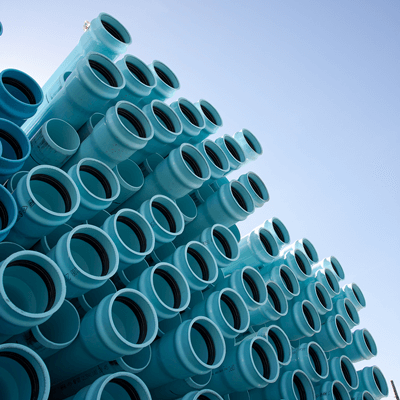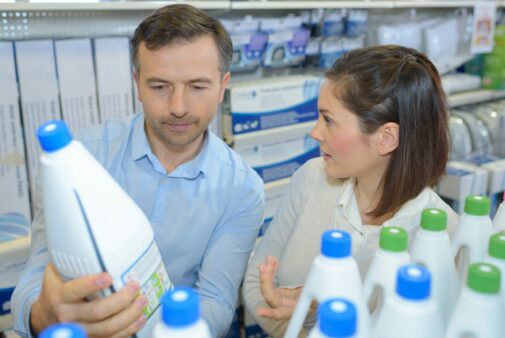Key Points/Overview
Through a chemical reaction, ethylene and chlorine combine to form ethylene dichloride which, in turn, is transformed into a gas called vinyl chloride monomer (VCM). The next step, called “polymerization,” converts the monomer into vinyl polymer, a fine-grained, white powder or resin known as polyvinyl chloride (PVC), or simply “vinyl.”1
Vinyl chloride is mainly used in the production of PVC, which is found in a variety of products and materials including household and water main pipes and drains, flooring, siding, cables, medical devices, and many other products used in everyday life.
While vinyl chloride is a building block chemical in the production of PVC, manufacturers convert as much vinyl chloride into PVC as possible to make maximum use of this raw material, then apply steam to strip out the remaining vinyl chloride so that levels in the finished vinyl are negligible.
Vinyl chloride is a highly flammable colorless gas. It is a reactive compound but is stable under recommended storage and handling conditions.2
Uses & Benefits
Vinyl chloride is primarily used in the production of PVC, or more simply known as “vinyl,” a material widely used to manufacture a variety of plastic and vinyl products and which comprises approximately 12 percent of the total use of plastics worldwide.3 PVC is a critical element used to manufacture a broad range of products and materials including pipes, wire and cable coatings, floor coverings, packaging materials, medical devices, and more. It is also a key component of such products as credit cards, furniture, housewares, and automobile parts and upholstery.

Safety Information
Vinyl Chloride Exposure
While vinyl chloride is a building block chemical in the production of PVC, manufacturers convert as much vinyl chloride into PVC as possible to make maximum use of this raw material, then apply steam to strip out the remaining vinyl chloride so that levels in the finished vinyl are negligible.
Because vinyl chloride usually exists in a gaseous state, any exposure is most likely to occur by inhalation. According to the U.S. Agency for Toxic Substances and Disease Registry (ATSDR), vinyl chloride is not normally found in urban, suburban, or rural air in amounts that are detectable by the usual methods of analysis.4
Ambient air concentrations of vinyl chloride are generally quite low; potential emissions sources include the discharge of exhaust gases from factories that manufacture or process vinyl chloride, or evaporation from areas where chemical wastes are stored.5 Vinyl chloride also has been found in tobacco smoke at very low levels.
Vinyl chloride is stored as a liquid. Containers used for handling vinyl chloride at atmospheric temperature are under pressure. The equipment used for VCM transport is specially designed to be impact and corrosion resistant.
Workplace Exposure
Exposure to vinyl chloride can occur in the workplace via inhalation. Occupational exposure to vinyl chloride may occur in workers involved in the production, use, transport, storage, and disposal of the chemical. The OSHA Permissible Exposure Limit-8 Hour Time Weighted Average (PEL-TWA) is 1 part per million.6
With inhalation exposure, depending on exposure duration, vinyl chloride can act as a Central Nervous System (CNS) depressant, resulting in headache, dizziness, disorientation and lightheadedness. Extremely high exposures can result in fatal CNS depression.7
The Clean Water Act requires the U.S. Environmental Protection Agency (EPA) to develop criteria for surface water quality that reflect the latest scientific knowledge on the impacts of pollutants on human health and the environment. EPA established Water Quality Criteria for vinyl chloride of 0.025 micrograms per liter (μg/L) of water to protect human health from “water + organism” ingestion and 1.6 μg/L of water for consumption of “organisms only.”8
Sources
- The Vinyl Institute
- CAMEO Chemicals
- WHO (1999). Vinyl Chloride (Environmental Health Criteria 215). Geneva: World Health Organization.
- U.S. Department of Health and Human Services, Agency for Toxic Substances and Disease Registry: Toxicological Profile for Vinyl Chloride
- Environmental Protection Agency Vinyl Chloride Snapshot
- Occupational Safety and Health Administration
- The Chlorine Institute: Vinyl Chloride Monomer Release Fact Sheet
- National Recommended Water Quality Criteria – Human Health Criteria Table | U.S. Environmental Protection Agency
- U.S. Department of Health and Human Services, Agency for Toxic Substances and Disease Registry
- The Chlorine Institute: Vinyl Chloride Monomer Release Fact Sheet


